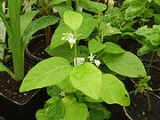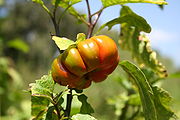
Solanum aethiopicum
Encyclopedia
Ethiopian Eggplant nakati or Solanum aethiopicum is a fruiting plant
of the genus
Solanum
mainly found in Asia
and Tropical Africa
. It is also known as Mock Tomato, Garden Eggs and Ethiopian Nightshade. These names are a result of its varied morphology, with ripe fruit often looking like a cross between an eggplant and a tomato
, which are also from Solanum. In fact, the Ethiopian Eggplant was so much confused with the ordinary eggplant that this was considered by some a variety violaceum of S. aethiopicum.
Ethiopian Eggplant may have originated from the domestication of Solanum anguivi. The Scarlet Eggplant, also known as Gilo or jiló, was long held to be a distinct species (S. gilo) but is nowadays generally considered to be a cultivar
group of S. aethiopicum.
and are actually more nutritious than the fruit
.
The highly variable fruit of the plant is eaten both raw and cooked and is becoming more popular as a cultivated crop. These fruits are usually harvested while still green, before the skin becomes thick. The bitterness depends on the levels of saponin
it contains, some with a sweet flavor and others very bitter. When the berries mature, they turn bright red because of high carotene
content.
A traditional food plant in Africa, this little-known vegetable has potential to improve nutrition, boost food security, foster rural development and support sustainable landcare.
Solanum aethiopicum is used as an ornamental in Asia.
 Currently there is a large movement towards increased cultivation of Solanum aethiopicum in West Africa. It grows all year long and can produce high fruit yields. However, low germination rates are an obstacle to wider cultivation.
Currently there is a large movement towards increased cultivation of Solanum aethiopicum in West Africa. It grows all year long and can produce high fruit yields. However, low germination rates are an obstacle to wider cultivation.
The only place where S. aethiopicum is grown to a significant extent in Europe lies in South Italy, to be precise in Rotonda in the Basilicata
, where this plant is of some commercial importance. Probably it was introduced by veterans returning from East Africa after the colonial war in the late 19th century.
Italian Farmer
Plant
Plants are living organisms belonging to the kingdom Plantae. Precise definitions of the kingdom vary, but as the term is used here, plants include familiar organisms such as trees, flowers, herbs, bushes, grasses, vines, ferns, mosses, and green algae. The group is also called green plants or...
of the genus
Genus
In biology, a genus is a low-level taxonomic rank used in the biological classification of living and fossil organisms, which is an example of definition by genus and differentia...
Solanum
Solanum
Solanum, the nightshades, horsenettles and relatives, is a large and diverse genus of annual and perennial plants. They grow as forbs, vines, subshrubs, shrubs, and small trees, and often have attractive fruit and flowers. Many formerly independent genera like Lycopersicon or Cyphomandra are...
mainly found in Asia
Asia
Asia is the world's largest and most populous continent, located primarily in the eastern and northern hemispheres. It covers 8.7% of the Earth's total surface area and with approximately 3.879 billion people, it hosts 60% of the world's current human population...
and Tropical Africa
Africa
Africa is the world's second largest and second most populous continent, after Asia. At about 30.2 million km² including adjacent islands, it covers 6% of the Earth's total surface area and 20.4% of the total land area...
. It is also known as Mock Tomato, Garden Eggs and Ethiopian Nightshade. These names are a result of its varied morphology, with ripe fruit often looking like a cross between an eggplant and a tomato
Tomato
The word "tomato" may refer to the plant or the edible, typically red, fruit which it bears. Originating in South America, the tomato was spread around the world following the Spanish colonization of the Americas, and its many varieties are now widely grown, often in greenhouses in cooler...
, which are also from Solanum. In fact, the Ethiopian Eggplant was so much confused with the ordinary eggplant that this was considered by some a variety violaceum of S. aethiopicum.
Ethiopian Eggplant may have originated from the domestication of Solanum anguivi. The Scarlet Eggplant, also known as Gilo or jiló, was long held to be a distinct species (S. gilo) but is nowadays generally considered to be a cultivar
Cultivar
A cultivar'Cultivar has two meanings as explained under Formal definition. When used in reference to a taxon, the word does not apply to an individual plant but to all those plants sharing the unique characteristics that define the cultivar. is a plant or group of plants selected for desirable...
group of S. aethiopicum.
Uses
The leaves of Solanum aethiopicum are eaten as a leaf vegetableLeaf vegetable
Leaf vegetables, also called potherbs, green vegetables, greens, leafy greens or salad greens, are plant leaves eaten as a vegetable, sometimes accompanied by tender petioles and shoots...
and are actually more nutritious than the fruit
Fruit
In broad terms, a fruit is a structure of a plant that contains its seeds.The term has different meanings dependent on context. In non-technical usage, such as food preparation, fruit normally means the fleshy seed-associated structures of certain plants that are sweet and edible in the raw state,...
.
The highly variable fruit of the plant is eaten both raw and cooked and is becoming more popular as a cultivated crop. These fruits are usually harvested while still green, before the skin becomes thick. The bitterness depends on the levels of saponin
Saponin
Saponins are a class of chemical compounds, one of many secondary metabolites found in natural sources, with saponins found in particular abundance in various plant species...
it contains, some with a sweet flavor and others very bitter. When the berries mature, they turn bright red because of high carotene
Carotene
The term carotene is used for several related unsaturated hydrocarbon substances having the formula C40Hx, which are synthesized by plants but cannot be made by animals. Carotene is an orange photosynthetic pigment important for photosynthesis. Carotenes are all coloured to the human eye...
content.
A traditional food plant in Africa, this little-known vegetable has potential to improve nutrition, boost food security, foster rural development and support sustainable landcare.
Solanum aethiopicum is used as an ornamental in Asia.
Cultivation

The only place where S. aethiopicum is grown to a significant extent in Europe lies in South Italy, to be precise in Rotonda in the Basilicata
Basilicata
Basilicata , also known as Lucania, is a region in the south of Italy, bordering on Campania to the west, Apulia to the north and east, and Calabria to the south, having one short southwestern coastline on the Tyrrhenian Sea between Campania in the northwest and Calabria in the southwest, and a...
, where this plant is of some commercial importance. Probably it was introduced by veterans returning from East Africa after the colonial war in the late 19th century.
Italian Farmer
Selected cultivars
- 'Turkish Orange' or 'Turkish Italian'
- The fruits of this variety are about two inches in diameter and turn bright orange-red when ripe, although they are usually eaten when still green. The sweet taste is often used in Thai curry. It can produce fruit within just 75 days after planting.
- 'Sweet Red'
- These striped fruits, just 1 inch in diameter, have a strong but non-bitter flavor. The plant is thornless and grows up to 3 feet tall and can produce fruit 125 days after planting.
- 'Small Ruffled Red', 'Red Ruffles', or 'Hmong Red'
- The two-inch berries of the 'Hmong Red' have deep creases and a bitter flavor used in Southeast Asian cooking. It can produce fruit 100 days after planting.
External links
- Cultivars list with descriptions
- Ethiopian Plant Names
- Information from AVRDC-Regional Center for Africa
- Solanum aethiopicum L. on Solanaceae Source - Specimens and a full list of scientific synonyms.

